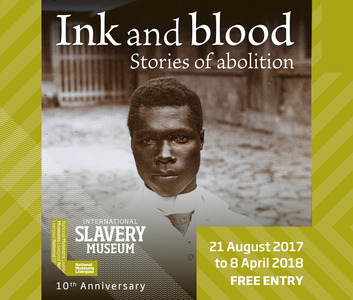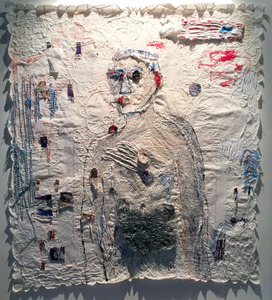Donkor, K and Symington, C (2017) Ink and Blood: Stories of Abolition. Liverpool International Slavery Museum, 21 August 2017 - 02 September 2018.
Abstract
The exhibition concerns the Transatlantic Slave Trade, its abolition and modern slavery. The focus is on the lives and personal stories of slaves from Argentina, Cuba, Jamaica, the United States and Bahrain. The 2 works by Alice Kettle depict portraits of cotton slaves. These portraits act as companion pieces showing the past and present of cotton production, foundational to 20th century British prosperity and centered in the North West. These works show slavery bound into the sites of production, consumption and trade of cotton. Adam represents the plantation slaves of the 18th and 19th centuries. This work uses an old cotton table cloth with embroidered cutwork acting like tattoos or the branding iron marks signifying ownership and slavery. These symbolise the circularity of continental slave trading and cotton. The production of the raw cotton material for Cottonopolis, the metropolis of 19thc textile production in Lancashire, drove the industrial revolution. Arkwright's new steam driven textile opened in 1781, placed Manchester as the international centre of global cotton manufacture. The cottons that were woven in Manchester were shipped to Africa from Liverpool and exchanged for African slaves, who were subsequently taken across the Atlantic to be sold to cotton farmers in the American South. The British then purchased the raw cotton at low prices to ship back to Britain. The second work shows the modern day sweatshop slave, who works in the factories of the Indian subcontinent and Bangledesh, to supply cheap clothing for the western clothing market. Both portraits seek to elevate and dignify the slavery and comment on the nature of freedom. Cotton in its material symbolises the political, geographical and socio-economic connections between Gujurat and Lancashire. It offers a reflection on the nature of post colonialist discourse.
Repository staff only
 |
Edit record |



![[img]](https://e-space.mmu.ac.uk/619686/1.hassmallThumbnailVersion/18113-AD_Culture_IB_Tile_banner_AW.jpg)
![[img]](https://e-space.mmu.ac.uk/619686/7.hassmallThumbnailVersion/img_2014.jpg)